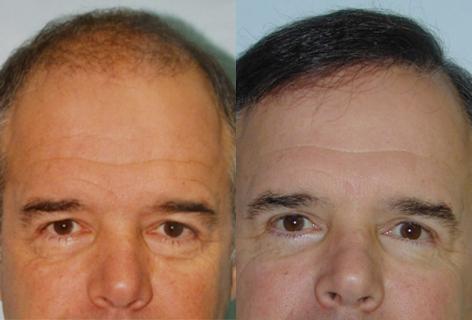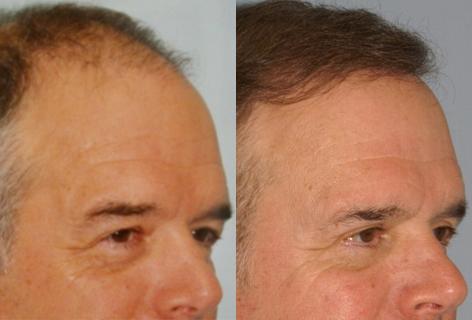In recent years great change has occurred in the way many surgeons perform hair transplants. Our San Francisco clinic and others have adopted the use of the dissecting microscope to create hair grafts of the smallest possible size which retains the natural characteristics of hair growth.

Microscopic Follicular Unit Grafting:
By natural characteristics of follicular unit hair growth, we mean the pattern of hair follicles as they grow out from the skin. If one looks at the scalp with 5-10 powers of magnification, we see that hairs grow out of the skin in groups of one, two, three, and four hairs. The human scalp averages one follicular unit per 1mm and each unit averages 2.2 hairs. Therefore a strip of scalp 1cm in width and 10 cm in length could yield 1000 follicular unit grafts (2200 hairs) for hair restoration surgery. This is the way nature grows hair, and the closest we can come surgically is to move hair in these follicular units in their natural groups, cutting away the non-hair-bearing skin between them, and then transplanting them into tiny slits on the top of the head. With most balding situations, two or three graft sessions may be necessary to give maximal potential results. In many instances, one session may be satisfactory for a particular patient. We do up to 3400 grafts in a session.
By keeping hair transplants as small as possible, yet keeping the follicular units intact, one can create a natural-looking appearance. It should be understood, though, that the density with follicular unit grafting will mathematically fall short of the normal, pre-bald hair covering. We cannot give additional hair to a patient. We are simply moving the hair that is genetically programmed not to be bald. If one can achieve 60% of normal density for a particular area, the average eye cannot distinguish that from full density.
We work together for one goal:
In performing large sessions of follicular unit hair transplants, it is necessary to have a team of physicians, nurses, and technicians who can do the labor-intensive tasks of harvesting the donor hair, performing a trichophytic plastic surgery closure of the donor site, cutting the donor hair under microscopes into hundreds (or thousands) of these small follicular unit grafts and then inserting them into precisely created slits made with various sized small needles in order to create a natural pattern for future hair growth. In our clinic, we have up to five assistants working a follicular unit hair transplant case, alternating assistants to lessen the fatigue factor. The skill and experience of these assistants is crucial to efficient and successful modern-day follicular unit hair grafting. It is not uncommon for us to perform 3000+ grafts in a session when indicated.
Local Anesthesia helps the hair transplant process:
Many clinics perform follicular unit hair transplants under local anesthesia only. This allows the patient to be fully alert through the procedure and be able to drive himself home afterwards. In our hair restoration clinic, we offer intravenous and oral sedation to patients so they may be sleepy or unaware through a good part of the procedure. If they do wish to drive themselves or take public transportation without assistance, we offer local anesthesia alone or with nitrous oxide. Nitrous oxide is the “laughing gas” used commonly in dentistry. We have the patient breathe the nitrous oxide while the local anesthesia is being administered, thereby making the injection of local anesthesia hardly noticeable. With either scenario, the operation is painless once the scalp is anesthetized. When sedation is used, the 3-7 hr. period of work is but a vague memory.
Postoperatively, we occasionally put a dressing on the back of the head to collect any drainage. The first night, this is removed. Often we do not put a dressing on the top of the head. A cap can be worn after surgery to hide any evidence of the procedure. We keep a supply of baseball caps for those who might not bring one.
Most patients can wash their hair gently the day after surgery. The second day after surgery, they can gently shampoo and, on the third day, they may use their usual hairstyling methods. The stitches or staples used for closure in the back of the head are removed in eleven to fourteen days.
I love my new hairline and I couldn’t be happier. I have no complaints. I am not feeling very much pain at all. I go about my daily activities and I don’t have any problems. Sincerely,
Possible Complications that may occur:
A few problems and complications can occasionally occur with follicular unit hair transplantation. The most frequently seen problems relate to swelling of the forehead, which can occur and subside within the first week after surgery, and small pimples that may form at some of the graft sites during the first three or four months after the procedure. The swelling, if it occurs, goes away spontaneously. We employ certain measures (injecting Triamcinolone with the local anesthetic) during surgery to lessen the incidence of swelling to where we see this phenomenon in perhaps one out of 15 cases. The pimples or cysts that form are treated by simply opening them, if they occur. We have the patients return for inspection to be sure that these potential problems are addressed early.
Fallout (“shock loss”)
A common occurrence after large sessions of follicular unit hair grafts is temporary fall-out of previously transplanted follicular unit grafts or from some of the thinning, balding hair. Because of changes in circulation that occur from the many punctures in the scalp, some follicular hairs are shocked. By “shocked”, we mean that the blood supply is temporarily diminished, causing the hair to go through a premature hair-growth cycle where the hair falls out and re-grows again. If this happens, do not be alarmed. The previously transplanted follicular hairs will all grow back, along with the newly transplanted follicular hairs. It should be emphasized that follicular unit hair grafts, when they are transplanted, take an average of three months before new growth appears above the surface of the skin, with some taking as long as nine months. Little crusts that develop and hairs that are in the follicular unit grafts, fall off within the first two to three weeks, but this and the shedding of other hairs is no cause for concern.
Doll’s Hair Look
In our facility, we have been doing hair grafting since 1973. In the “old days”, prior to follicular unit transplant techniques, hair grafting was done with the larger grafts, which have pretty much been abandoned for the smaller follicular unit grafts described in this writing. These older style grafts, often referred to as “plugs”, often resulted in the “corn row” or “doll’s hair” look. This was due to large grafts compressed into smaller recipient holes and standing out by themselves. By dividing the donor source into smaller follicular unit grafts, we spread the hair around more diffusely and, therefore, get a more natural non-compressed look. We try to prevent an appearance that looks either like a doll’s hair or a wall of dense hair.
Neograft Hair Transplantation
Neograft Hair Transplantation is a minimally invasive hair transplant technique, results couldn’t look more natural. Here are the top 5 reasons why people choose the NeoGraft procedure to fight hair loss:
- It’s a minimally invasive procedure for hair restoration (no stitches or staples)
- There is little-to-no discomfort (no scalpel involved)
- The recovery time is quick (patients resume normal activity after only a few days)
- The hair line is natural-looking (no linear scar)
- Financing programs are available (many physicians have options to meet their patients’ hair transplant budgets)
A Hair Replacement Solution Like No Other
NeoGraft’s minimally invasive hair transplant procedure is a much more desirable option for both men and women as opposed to traditional hair restoration methods.
The NeoGraft Automated Hair Transplantation system is a leading edge technology for men and women looking to restore their hairline using the Follicular Unit Extraction (FUE) method to gently remove the individual follicles from the back of the head (the “donor area”) in their naturally occurring groupings of about 1-4 hairs.
The follicles are then artistically implanted in the areas of the scalp where balding has occurred to complement the facial structure and current hairline, resulting in a discrete, natural-looking hair transplant.
Take the next step:
Schedule a Consultation with your local Certified NeoGraft Physician today to determine the cause of your hair loss and to get professional advice on your hair replacement options.
Cost of Hair Transplants
The most frequent question we receive over the Internet is the request for the cost of hair transplant surgery.
The questions are in the form of cost per graft, cost to complete the result, or cost per session. These are difficult questions to answer without being able to examine the prospective patient. I realize that cost in many cases is as important as quality and that you want a reasonable idea of comparative costs. There are, however, too many factors to consider for an accurate price quote to be given online.
I think you will find our charges less than many large chain clinics as our overhead is less. Also, be sure when comparing costs that ALL costs of the procedure are included.
I can only give a firm guaranteed price quote upon an in-person consultation. If you have estimates from other reputable hair restoration surgeons, I could review those figures and based on them give a non-guaranteed, qualified estimate.
The information I have on modern hair grafting techniques has changed little since 2001 from my point of view. However, rather than rewrite the basic information, I would like viewers of this website to also view www.hairtransplantnetwork.com . I am a paying supporter of this website, which has a great deal of updated information from not only myself, but colleagues whose work I greatly respect. The cases and techniques used by my fellow members of the Hair Transplant Network are very similar to what I use in most of my hair grafting cases. Therefore, I would like you to get additional information and look at comparative techniques on www.hairtransplantnetwork.com . I would be glad to address any questions regarding technique, possible cost, and scheduling a consultation also.

